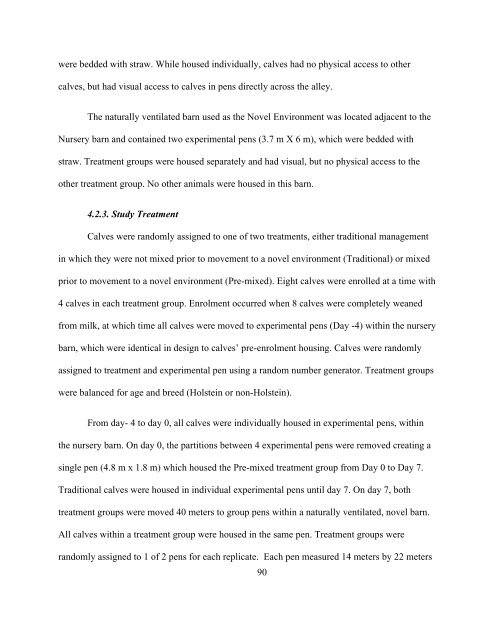Stanton PhD Thesis final_docx - Atrium - University of Guelph
Stanton PhD Thesis final_docx - Atrium - University of Guelph
Stanton PhD Thesis final_docx - Atrium - University of Guelph
Create successful ePaper yourself
Turn your PDF publications into a flip-book with our unique Google optimized e-Paper software.
were bedded with straw. While housed individually, calves had no physical access to other<br />
calves, but had visual access to calves in pens directly across the alley.<br />
The naturally ventilated barn used as the Novel Environment was located adjacent to the<br />
Nursery barn and contained two experimental pens (3.7 m X 6 m), which were bedded with<br />
straw. Treatment groups were housed separately and had visual, but no physical access to the<br />
other treatment group. No other animals were housed in this barn.<br />
4.2.3. Study Treatment<br />
Calves were randomly assigned to one <strong>of</strong> two treatments, either traditional management<br />
in which they were not mixed prior to movement to a novel environment (Traditional) or mixed<br />
prior to movement to a novel environment (Pre-mixed). Eight calves were enrolled at a time with<br />
4 calves in each treatment group. Enrolment occurred when 8 calves were completely weaned<br />
from milk, at which time all calves were moved to experimental pens (Day -4) within the nursery<br />
barn, which were identical in design to calves’ pre-enrolment housing. Calves were randomly<br />
assigned to treatment and experimental pen using a random number generator. Treatment groups<br />
were balanced for age and breed (Holstein or non-Holstein).<br />
From day- 4 to day 0, all calves were individually housed in experimental pens, within<br />
the nursery barn. On day 0, the partitions between 4 experimental pens were removed creating a<br />
single pen (4.8 m x 1.8 m) which housed the Pre-mixed treatment group from Day 0 to Day 7.<br />
Traditional calves were housed in individual experimental pens until day 7. On day 7, both<br />
treatment groups were moved 40 meters to group pens within a naturally ventilated, novel barn.<br />
All calves within a treatment group were housed in the same pen. Treatment groups were<br />
randomly assigned to 1 <strong>of</strong> 2 pens for each replicate. Each pen measured 14 meters by 22 meters<br />
90

















